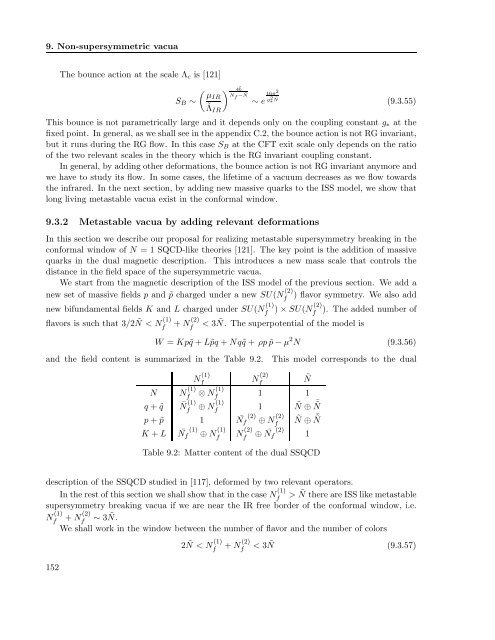Perturbative and non-perturbative infrared behavior of ...
Perturbative and non-perturbative infrared behavior of ...
Perturbative and non-perturbative infrared behavior of ...
You also want an ePaper? Increase the reach of your titles
YUMPU automatically turns print PDFs into web optimized ePapers that Google loves.
9. Non-supersymmetric vacua<br />
The bounce action at the scale Λc is [121]<br />
4<br />
µIR<br />
SB ∼<br />
˜ΛIR<br />
˜b Nf −Ñ ∼ e 16π2<br />
g 2 ∗ Ñ (9.3.55)<br />
This bounce is not parametrically large <strong>and</strong> it depends only on the coupling constant g∗ at the<br />
fixed point. In general, as we shall see in the appendix C.2, the bounce action is not RG invariant,<br />
but it runs during the RG flow. In this case SB at the CFT exit scale only depends on the ratio<br />
<strong>of</strong> the two relevant scales in the theory which is the RG invariant coupling constant.<br />
In general, by adding other deformations, the bounce action is not RG invariant anymore <strong>and</strong><br />
we have to study its flow. In some cases, the lifetime <strong>of</strong> a vacuum decreases as we flow towards<br />
the <strong>infrared</strong>. In the next section, by adding new massive quarks to the ISS model, we show that<br />
long living metastable vacua exist in the conformal window.<br />
9.3.2 Metastable vacua by adding relevant deformations<br />
In this section we describe our proposal for realizing metastable supersymmetry breaking in the<br />
conformal window <strong>of</strong> N = 1 SQCD-like theories [121]. The key point is the addition <strong>of</strong> massive<br />
quarks in the dual magnetic description. This introduces a new mass scale that controls the<br />
distance in the field space <strong>of</strong> the supersymmetric vacua.<br />
We start from the magnetic description <strong>of</strong> the ISS model <strong>of</strong> the previous section. We add a<br />
new set <strong>of</strong> massive fields p <strong>and</strong> ˜p charged under a new SU(N (2)<br />
f ) flavor symmetry. We also add<br />
new bifundamental fields K <strong>and</strong> L charged under SU(N (1)<br />
f<br />
flavors is such that 3/2Ñ < N(1)<br />
f + N(2)<br />
f<br />
) × SU(N(2)<br />
f<br />
< 3Ñ. The superpotential <strong>of</strong> the model is<br />
). The added number <strong>of</strong><br />
W = Kp˜q + L˜pq + Nq˜q + ρp ˜p − µ 2 N (9.3.56)<br />
<strong>and</strong> the field content is summarized in the Table 9.2. This model corresponds to the dual<br />
N N (1)<br />
q + ˜q<br />
f<br />
¯ N (1)<br />
f<br />
N (1)<br />
f<br />
N (2)<br />
f<br />
Ñ<br />
⊗ N(1)<br />
f 1 1<br />
⊕ N(1)<br />
f 1 Ñ ⊕ ¯ Ñ<br />
p + ˜p 1 ¯ Nf (2) ⊕ N (2)<br />
f<br />
K + L ¯<br />
Nf (1) ⊕ N (1)<br />
f<br />
N (2)<br />
f<br />
⊕ Nf<br />
¯ (2)<br />
Ñ ⊕ ¯ Ñ<br />
Table 9.2: Matter content <strong>of</strong> the dual SSQCD<br />
description <strong>of</strong> the SSQCD studied in [117], deformed by two relevant operators.<br />
In the rest <strong>of</strong> this section we shall show that in the case N (1)<br />
f > Ñ there are ISS like metastable<br />
supersymmetry breaking vacua if we are near the IR free border <strong>of</strong> the conformal window, i.e.<br />
N (1)<br />
f + N(2)<br />
f ∼ 3Ñ.<br />
We shall work in the window between the number <strong>of</strong> flavor <strong>and</strong> the number <strong>of</strong> colors<br />
152<br />
2Ñ < N(1)<br />
f + N(2)<br />
f < 3Ñ (9.3.57)<br />
1
















